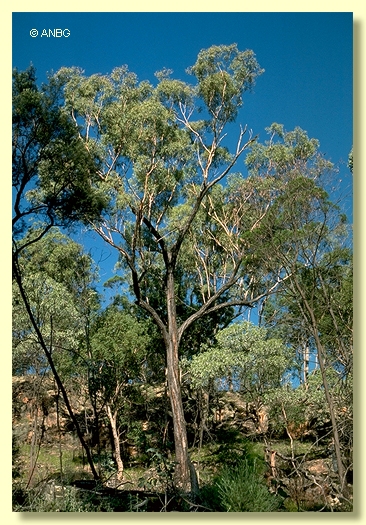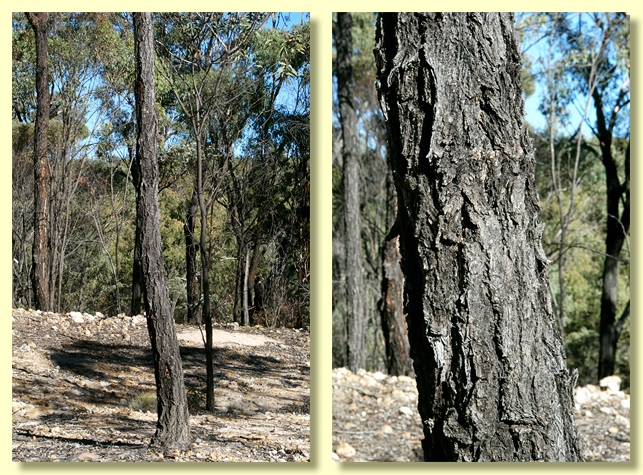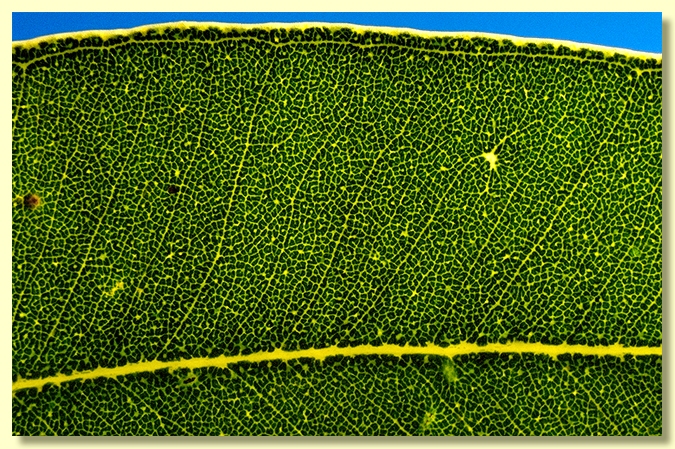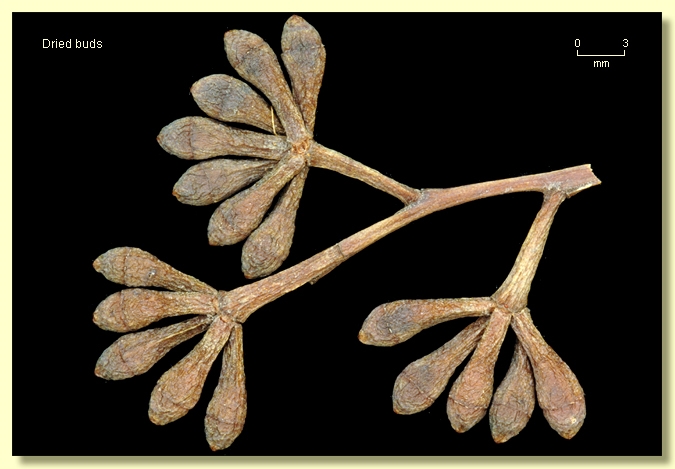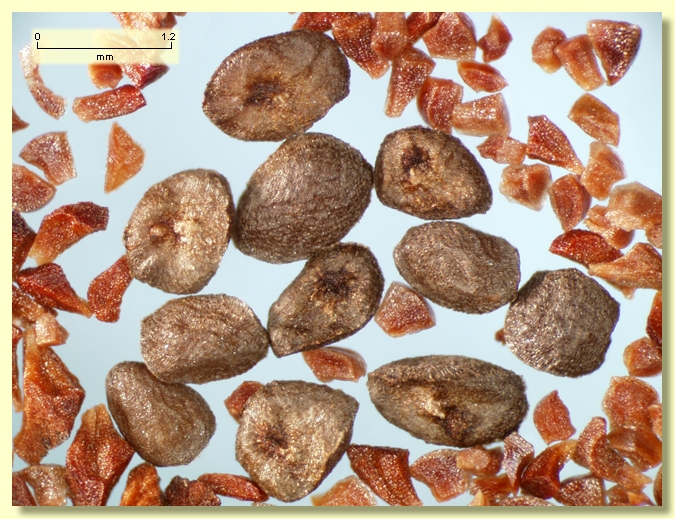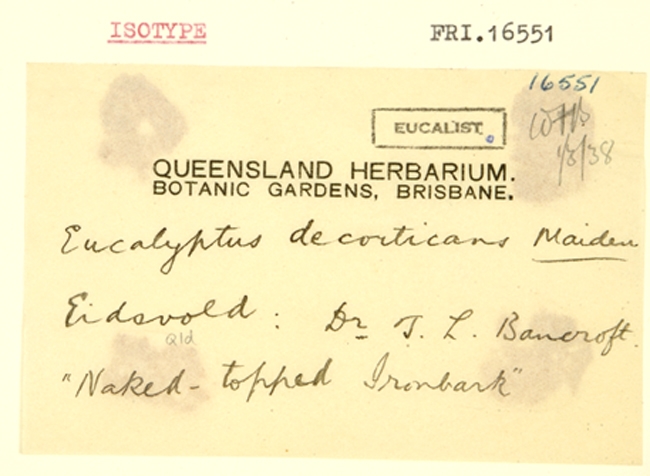Euclid - Online edition
Eucalyptus decorticans
Eucalyptus | Symphyomyrtus | Adnataria | Apicales | Siderophloiae | Subglaucae
Eucalyptus decorticans (F.M.Bailey) Maiden, Crit. Revis. Eucalyptus 5: 231 (1921).
Eucalyptus siderophloia f. decorticans F.M.Bailey, Queensland Agric. J. 26: 127 (1911). T: Queensland: Eidsvold, T.L.Bancroft s.n. anno 1911; lecto BRI [AQ099803]: fide Bean, A.R., Telopea 12(3): 311-312 (2009); ?isolecto: CANB.
Tree to 40 m tall. Forming a lignotuber.
Ironbark on trunk and larger branches, dark grey or black, smaller branches conspicuously smooth-barked, white to grey-white to yellow to orange.
Juvenile growth (coppice or field seedlings to 50 cm): stem rounded or square in cross-section; juvenile leaves opposite for a few pairs, then alternate, petiolate, narrowly lanceolate, 5–9 cm long, 0.5–1.5 cm wide, discolorous, grey-green or green.
Adult leaves alternate, petiole 1–2.5 cm long; blade lanceolate to falcate, 5.5–12.5(17) cm long, 1–3 cm wide, base tapering to petiole, concolorous, dull, green to blue-green, side-veins at an acute or sometimes wider angle to midrib, very densely reticulate, intramarginal vein parallel to and just within margin, oil glands sparse and mostly intersectional.
Inflorescence terminal compound, or axillary compound or axillary single umbels, peduncles 0.5–1.5 cm long, buds 7 per umbel, pedicels 0.2–0.6 cm long. Mature buds clavate to fusiform to diamond-shaped, 0.6–0.7 cm long, 0.3–0.4 cm wide, smooth, scar present, operculum conical, stamens usually irregularly flexed, anthers adnate, cuboid, dehiscing by broad lateral pores or slits, style long, stigma blunt or pin-head shaped, locules 4, the placentae each with 4 vertical ovule rows. Flowers white.
Fruit pedicellate (pedicels 0.2–0.7 cm long), obconical or cup-shaped to barrel-shaped, rarely cylindrical, 0.7–0.9 cm long, 0.5–0.6 cm wide, disc descending, valves usually 4, near rim level or enclosed or slightly exserted.
Seeds brown, 1–2 mm long, ovoid or flattened-ovoid, dorsal surface shallowly pitted, hilum ventral.
Cultivated seedlings (measured at ca node 10): cotyledons reniform to oblong; stems square in cross-section; leaves always petiolate, opposite for 3–8 nodes then alternate, linear-lanceolate, 4.8–11 cm long, 0.8–1.5 cm wide, base tapering, dull, green, discolorous.
Flowering has been recorded in April, August and September.
A medium-sized ironbark tree widespread in south-east Queensland from sandstone hills in the Wondul Range area north-west of Inglewood, north through the Haden–Dalby–Jandowae–Gayndah area to just south of Monto, then westwards through the Expedition Range east of Rolleston to the Drummond Range area north of Tambo and the Cheston Range area north-east of Morven, with an outlier in the northern section of the Drummond Range near Miclere just N of Clermont. Eucalyptus decorticans is characterised by the conspicuously smooth-barked branches in the upper canopy, the diamond-shaped to obovoid buds and lanceolate juvenile leaves.
Within its sub-group it is closest to E. siderophloia and E. rhombica. All three species have diamond-shaped buds with a conical operculum. It can be separated from E. siderophloia by its conspicuously smooth-barked branches in the upper canopy, rough-barked in E. siderophloia. It can be separated from E. rhombica by its slightly smaller fruit, 0.6–0.7 cm wide in E. decorticans and 0.8–1 cm wide in E. rhombica. It is also closely related to E. fibrosa and can be separated from that species by its much narrower lanceolate juvenile leaves (E. fibrosa with ovate to orbicular to deltoid juvenile leaves). Within its area of occurrence there are four other ironbarks from this subgroup that have their stamens irregularly flexed and all the stamens fertile. They are E. crebra, E. tholiformis, E. beaniana and E. melanophloia. E. tholiformis and E. beaniana have more or less oblong buds with a bluntly conical to rounded operculum. E. tholiformis can be further separated by having ovate juvenile leaves. E. crebra usually has much smaller buds and fruit and rough-barked upper branches. E. melanophloia has glaucous, sessile opposite leaves in the mature crown.
All other ironbarks within its area of occurrence belong to other groups that have buds with stamens all regularly flexed and have an outer whorl of staminodes.
MORE ABOUT IRONBARKS
Eucalyptus decorticans: Latin decorticans, without bark, referring to the peeling bark on the medium sized to small branches.


